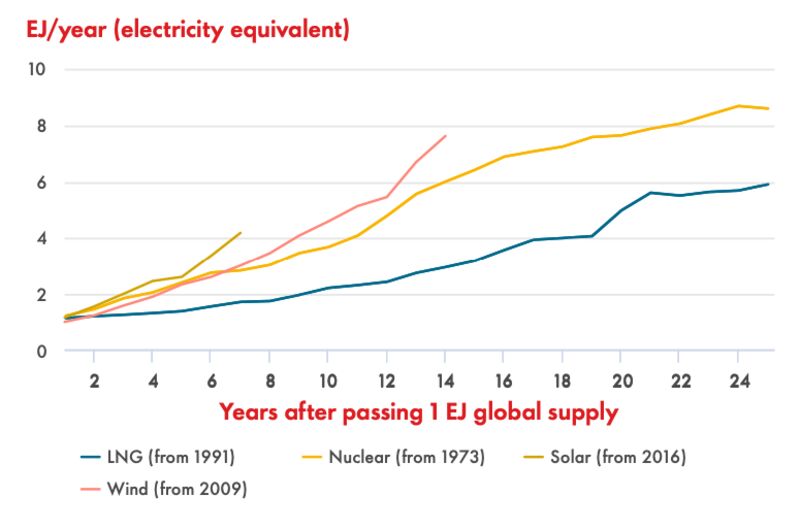- The steep trajectory of renewables is good news for decarbonization, with a caveat: New technologies need to work harder to make a dent in global energy demand.

Nathaniel Bullard, Bloomberg News
NEW YORK
EnergiesNet.com 04 03 2023
Shell Plc recently published two energy security scenarios, its latest in a long series of thorough and (at least to energy analysts) memorable views into energy’s possible futures. The first, called Archipelagos, is an extension of the world’s current path; the second, Sky 2050, works backward from an idealized outcome of net zero emissions and limited global temperature increase.
Notably, the Sky 2050 scenario sees high oil prices incentivizing demand reduction. That’s a prospect countries, which are already grappling with rising inflation, may face in the coming months after OPEC+’s unexpected decision this weekend to cut oil output.)
The report is packed with charts and projections, but there is one historical chart worth exploring in detail.
Shell examined the four major energy technologies to emerge in the past six decades: nuclear power, liquefied natural gas and solar and wind power. Each technology needed years before it made a meaningful, if minor, contribution to the global energy supply, a threshold Shell sets at one exajoule annually. (One exajoule is equivalent to 277 terawatt-hours — close to the electricity Mexico consumed in 2019.)
For example, the first grid-connected nuclear power plant began operations in the Soviet Union in 1954, and nuclear power reached 1 exajoule of global supply 19 years later. Solar took more than three decades to contribute an exajoule of supply, with the first commercial solar projects built in the early 1980s and the first exajoule not reached until 2016.
A technology’s speed after it hits that milestone is much more important than its speed before. Nuclear power doubled in the four years after, then doubled again within another five years. It now supplies more than eight times as much energy as it did 50 years ago. Liquefied natural gas had a slower start, taking nearly a decade to go from 1 exajoule to 2, and the same amount of time again to go from 2 to 4. Its progress leapt ahead in the late 2000s, nearly two decades after it supplied its first annual exajoule. But it still provides less energy than nuclear power today.
Growth of energy technologies after supplying 1 exajoule/yea

Wind is growing more rapidly than liquefied natural gas. Both took decades to reach their first exajoule, but wind has risen at a faster pace than LNG since then. Wind was on an almost identical path to nuclear power. But it has accelerated, and now supplies nearly 30% more energy in its 14th year past the milestone than nuclear did.
Solar is on its own path. A year after hitting the milestone, it already exceeded nuclear’s supply at the same stage. In its seventh year as a significant energy supplier, solar accounted for almost one-and-a-half times as much energy as nuclear. It supplied nearly two-and-a-half times as much energy as LNG six years post-exajoule.
This is a striking finding, and it is also promising for decarbonizing global energy — with one major distinction worth noting.
Global energy consumption has more than doubled in the 50 years since nuclear reached the 1 exajoule mark. In 1973, the world consumed 238 exajoules of energy; in 2021, it consumed 595, according to the latest BP Statistical Review . That means that in the year that nuclear first appears as a significant energy contributor, it supplied about 0.4% of the energy the world used. By the time that LNG hit an exajoule, it provided about 0.3%. By 2016, when solar provided its first exajoule, it met less than 0.2% of much-increased global energy demand.
On an absolute basis, today’s newest energy technologies are the fastest growing in at least 50 years. On a relative basis, though, they have more work to do to have the same global impact. Wind and solar together now generate more electricity than the world’s nuclear power fleet, but to have the equivalent impact that nuclear power had in the 1970s and 1980s, they will need to grow roughly twice as fast.
Fortunately, they are. Research group BloombergNEF expects 316 gigawatts of solar power to be added this year, and 110 more gigawatts of wind power as well. That continued growth would keep the trends in Shell’s chart fresh: The two fastest-growing energy technologies of the past five decades are likely to continue their path, and continue their impact too.
bloomberg.com 04 03 2023












